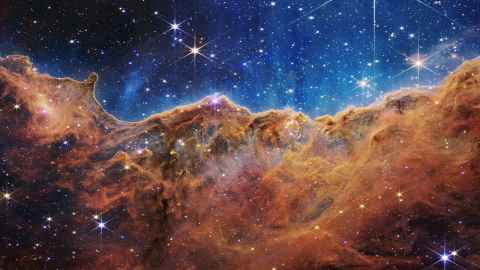The 13.7-billion year journey of the universe just became much clearer
18 July 2022
OPINION: The images from the James Webb Space Telescope let us glimpse the deep origins of the universe, writes Jan J. Eldridge.

The James Webb Space Telescope (JWST) needs to be called the "Just Wow Space Telescope." The new images it has delivered are of views of the universe we've seen before but the clarity and detail are like a masterpiece restored to its full glory.
The telescope has been decades in the making with a huge international team of thousands of scientists and engineers working to dream, imagine, design, and build JWST. What we have seen shows they have achieved exactly what those first dreams reached for.
Zooming in on these images reveals many new details. There are multiple faint arcs, comprising many small bright dots, each of which is a galaxy. The detail and information are astounding. The images have texture, there is “lumpiness” in the clouds of gas in which new stars are forming.
The other real power of JWST is that all the observations are in infrared light, with longer wavelengths than red. It’s the type of light that warms your hands when you hold them up to a hot object. JWST can look at the whole range of light at these wavelengths.
This is useful for two reasons. The wavelength of light a hot object emits depends on its temperature. For our sun at 6000 degrees this is in the middle of the optical spectrum, which equates to day light.
For cooler objects, like our own bodies with temperature of 37 degrees, is in the infrared wavelengths, so JWST can look at much cooler objects that are the same temperature as us (or colder). Now we can map out the temperature of different dust clouds or stellar winds to understand their dynamics.
The second reason concerns dust. These clouds of particles about the size of cigarette smoke scatter and obscure our usual view of distant stars. In the plane of our galaxy clouds of dust block out most stars. However, dust doesn’t scatter infrared light so we can see many more stars in our galaxy and galaxies across the universe previously cloaked in dust.
Habitable planets?
However as great as the images in the infrared are, the truly spectacular advance is the spectra that have been obtained. The first image released is an accurate observation of water in the atmosphere of a hot Jupiter-sized, exoplanet WASP-96b, a planet orbiting another star. While it's not habitable it shows that it is going to be much easier to study nearby exoplanets in our own galaxy.
The spectra transform our knowledge because the signature in the light of water is so clear. Previous studies have always had a significant uncertainty in the observations, but with these smaller errors no one can dispute the finding.
These smaller uncertainties also mean we’ll possibly be able to detect water on smaller planets, and maybe other molecules. This is the path to finding habitable planets around other stars, and maybe even indicators of life.
More remarkable for me is the second spectra released of one of the tiny dots in the deep-field image. This is a spectrum of a galaxy at a redshift of 8.5. This means we can see the cosmos as it was 13.1 billion years ago, when the universe was only 600 million years old.
The second spectra reveal multiple emission lines of oxygen, neon, and hydrogen. The fact they are so clear and so bright will transform our understanding of how galaxies, and the composition of elements, evolve through cosmic history. We also know the stars in these galaxies evolve differently to those in our own galaxy, so it opens new areas to investigate.
All of this can be gleaned from a few new images. With more results coming of objects near and far, the JWST is going to reveal so many new aspects of our universe. The images allow us to trace the history of the evolution of the universe, our galaxy and so, understand our own origins, which are part of the 13.7-billion-year journey for the universe.
Associate Professor Jan J. Eldridge is an astrophysicist and the head of the Physics Department at the University of Auckland.
This article reflects the opinion of the author and is not necessarily that of the University of Auckland. First published in Newsroom.
Media contact: Gilbert Wong, gilbert.wong@auckland.ac.nz